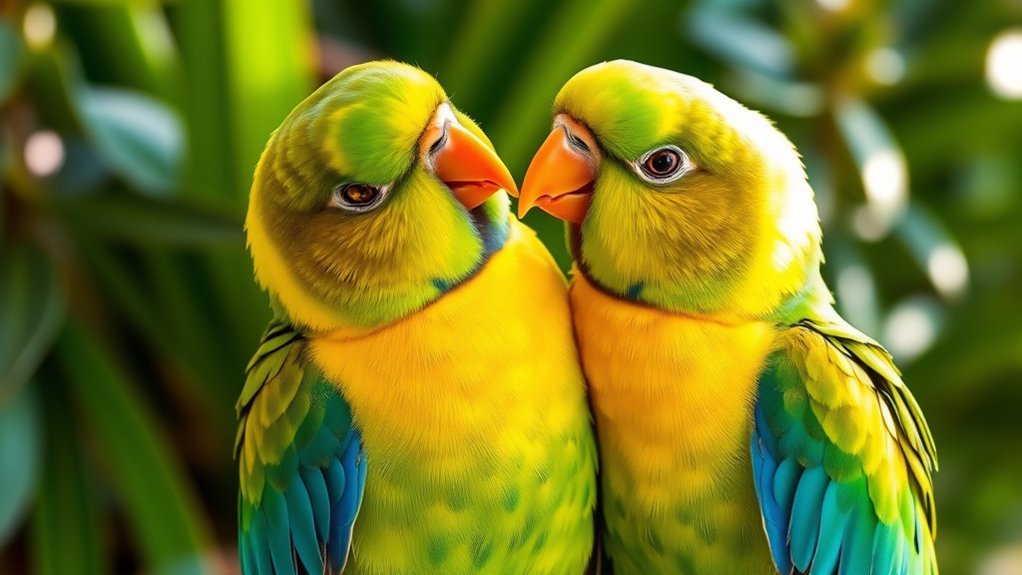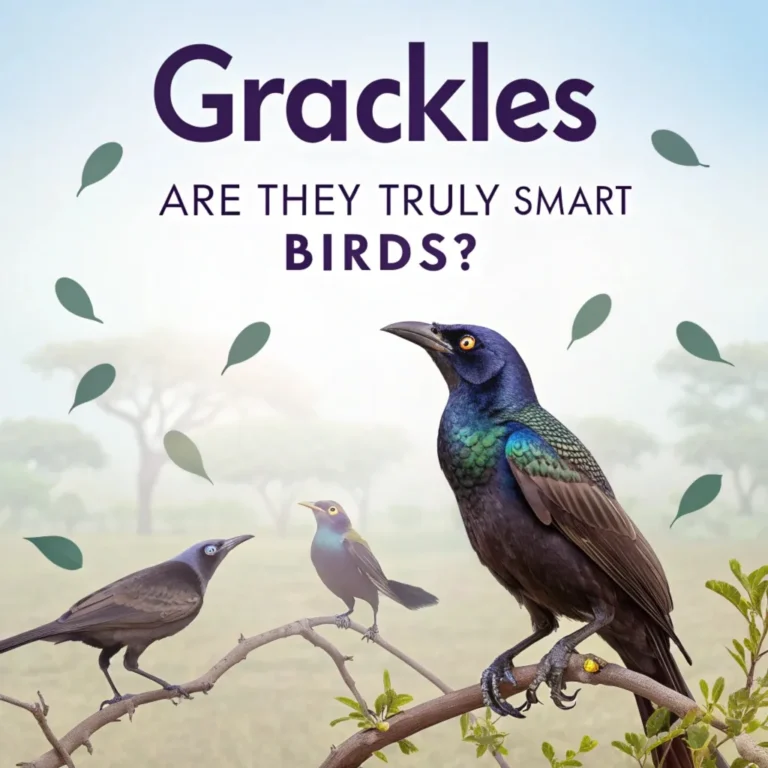Green Love Birds: Characteristics and Care Requirements
If you want a Green Love Bird as a pet, it's important to know how to take care of them. These colorful birds are fun and playful. They need more than just a cage and food to be happy and healthy.
First, Green Love Birds love to socialize. They enjoy spending time with people and other birds. Make sure to give them plenty of attention every day. They like to play, so having toys in their cage is a good idea.
Next, pay attention to their diet. Green Love Birds need a mix of seeds, fruits, and vegetables. Fresh food is really good for them. This helps keep them strong and full of energy.
Finally, watch their behavior. These birds can be very chatty and love to explore. Give them safe spaces outside their cage to play. This helps keep their minds busy and happy.
By understanding their needs, you can create a fun and loving home for your Green Love Bird. They will become a great friend and bring joy to your life!
A Quick Overview
Green Love Birds are small and colorful birds. They grow to be about 5 to 7 inches long. These birds are friendly and full of personality!
To keep your Green Love Bird healthy, feed it a mix of seeds, fresh fruits, and vegetables. You can also give them pellets made just for birds.
Make sure their cage is big enough. It should be at least 24x24x36 inches. The bars should go sideways, so they can climb easily. Place the cage in a lively spot where they can see and hear people.
Green Love Birds need daily playtime and attention. Spending time with them helps them feel happy and loved. They can get along well on their own, but they love company, too! Some people think they need a partner, but that's not true if they get enough love from their owners.
Lastly, they can be a bit noisy, but many people find their sounds pleasant. If you care for them right, these birds can bring a lot of joy to your life!
Overview of Green Love Birds

Green lovebirds, or lovebird parrots, are small and colorful birds from Africa. They belong to a group called Agapornis. People love them because of their bright feathers and friendly personalities.
These birds are very social and enjoy being around other birds and people. They form strong bonds with their owners and can be very affectionate. You can often see them playing, exploring, and doing silly things that make you smile.
To keep your lovebird happy, spend time with them every day. They thrive on attention and love to interact. Understanding where they come from can help you care for them better.
Their natural environment influences their friendly behavior, so creating a loving space for them will make your bond even stronger.
In short, green lovebirds are fun, loving pets that need lots of social contact to stay happy!
Physical Characteristics

Lovebirds are small but very colorful birds. They usually grow to be about 5 to 7 inches long. There are some slight size differences between different types of lovebirds.
Their feathers come in bright colors like green, yellow, blue, and peach, with fun patterns that make them look special. The Peach-faced Lovebird is a popular type, showing a pretty mix of green and pink.
Lovebirds have short, stubby tails and strong, curved beaks. Their beaks are great for cracking seeds open. These features make them not only look nice but also help them live well in different places.
Many people enjoy having lovebirds as pets because of their beauty and charm!
Behavioral Traits

Lovebirds are fun and friendly pets. They bring joy with their playful actions and sociable nature. Here are some important things to know about their behavior:
- Sounds: Lovebirds make different sounds, like chirps and squawks. They use these to show how they feel and to talk to each other.
- Play: They love to play! Swinging, climbing, and having toys are all ways they stay busy and happy.
- Cuddly Behavior: Lovebirds often cuddle or clean each other. This shows how much they care for one another.
- Curiosity: These birds are very curious. They want to explore everything around them, so it's important to make sure their environment is safe.
Social Needs
Lovebirds have strong social needs. They need to interact with people and other birds to be happy. If they're alone for too long, they might feel sad or stressed.
Spend time playing with your lovebird. Use toys and activities that let you both have fun together. Training them can help build trust between you.
If you can't be with your lovebird a lot, think about getting another lovebird. This way, they'll always have a friend.
A happy lovebird enjoys being social, which helps them live a healthier and happier life. So, make sure to give your little friend the love and attention they need!
Diet and Nutrition
A balanced diet is very important for your lovebird's health and happiness. It helps them stay active and feel good. Here are some simple tips to keep their meals healthy:
- Quality Seeds: Choose a mix of seeds. Focus on seeds that are good for them, like millet and canary seed.
- Fresh Fruits and Vegetables: Offer different fruits and veggies. Leafy greens, carrots, and berries are great choices for vitamins and minerals.
- Pelleted Diet: Add special pellets to their diet. These pellets provide all the nutrients they need and help them eat a variety of foods.
- Supplemental Foods: Sometimes, give them nuts or cooked grains. This adds fun and variety to their meals.
Following these tips will help your lovebird stay healthy and lively!
Housing Requirements
When picking a home for your lovebirds, think about their happiness. Start with a cage that's big enough for them to move around. A good size for two lovebirds is 24 inches deep, 24 inches wide, and 36 inches tall. This gives them room to climb and fly.
Choose a cage with horizontal bars so they can exercise easily.
Place the cage in a busy spot in your home. Keep it away from direct sunlight and drafts. Lovebirds love to be with people, so avoid putting their cage in a corner or a quiet area.
A well-placed and spacious cage helps keep your lovebirds happy and healthy.
Creating a Stimulating Environment
To help your lovebirds thrive, you need to create a fun and interesting space for them, just like their natural home.
Here are four simple ways to make their habitat better:
- Different Perches: Use perches made of various materials and shapes. This helps their feet stay healthy and keeps them active.
- Fun Toys: Add toys that make them think, like puzzles and foraging devices. These will keep their minds busy and entertained.
- Nature Elements: Include some branches, plants, or safe logs. This makes their area feel more like the outdoors and encourages them to explore.
- Spend Time Together: Play and hang out with your lovebirds. This helps them bond with you and improves their social skills.
Grooming and Hygiene
Grooming and hygiene are important for your lovebirds. They help keep your birds healthy and looking good. To take care of their feathers, check them often for dirt or pests. You can help your lovebirds preen by giving them fun toys and good places to perch.
Bathing is also key. You can let your lovebirds splash around in a shallow dish or mist them gently with water. This keeps their feathers clean.
Don't forget about their nails! Trim them every few weeks to stop them from getting too long. Long nails can hurt your birds and make it hard for them to walk. Be careful not to cut too deep, as this can cause bleeding.
Health Concerns
Lovebirds are usually healthy pets, but they can get sick sometimes.
It's important to know what problems they might face so you can help them stay well. Here are some common health issues to look out for:
- Feather Plucking: This can happen if they're stressed or bored. It means they pull out their own feathers, which can hurt them.
- Respiratory Infections: If your lovebird sneezes or wheezes, it might've an infection. Keep their space clean and free from drafts to help prevent this.
- Obesity: Lovebirds need a healthy diet to stay fit. If they eat too much, they can get overweight and face serious health problems.
- Avian Fatigue Syndrome: If your bird seems tired all the time, it could have this condition. Watch for signs of fatigue and take them to an avian vet if you notice anything unusual.
Bonding With Your Love Bird
Building a strong bond with your lovebird is important for both you and your bird. When you do fun activities together, you create trust and love.
Start by spending time in a quiet place. This helps your bird get used to you. Playing together is super important. Use toys like swings and mirrors that make your bird move and have fun. Talk softly to your bird while you play. This makes them feel safe.
You can also give your bird treats by hand. This helps them trust you more. Remember to be patient. Your lovebird might take some time to feel comfortable with you.
Introducing a New Love Bird
Bringing a new lovebird home is exciting!
But it's important to do it the right way so your new friend feels happy and safe.
Here are some easy steps to help you introduce your lovebird:
- Pick a good home: Make sure the cage is large enough. Add some perches and fun toys so it feels cozy and natural.
- Let it adjust: Keep your new bird in a separate room for a few days. This gives it time to get used to your home and all the new sounds.
- Meet and greet: After a few days, you can let your lovebirds meet in a neutral area. Watch how they act toward each other.
- Create a routine: Set a regular time for feeding and caring for both birds. This helps them feel safe and know what to expect.
With a bit of patience, you can help your lovebirds get along.
Enjoy your time with your feathered friends!
Common Myths About Green Love Birds
Green lovebirds are colorful and friendly pets that many people enjoy. However, there are some myths about them that can confuse new owners.
One myth is that lovebirds need a partner to be happy. While they do enjoy social interactions, some lovebirds can live happily alone if they get enough attention from their owner.
Another common myth is that lovebirds don't need much social time. In reality, lovebirds love to bond with their human friends. They thrive on interaction and play.
Some people think lovebirds are too noisy for homes. But their sounds can be quite sweet and playful. Many owners actually find their chirps charming.
By clearing up these myths, you can take better care of your lovebird. Understanding their needs will help you build a strong, loving relationship.
Enjoy your time with your feathered friend!
Tips for First-Time Owners
Owning green lovebirds can be a fun and happy experience. Here are some simple tips to help your new bird friends live well:
- Housing: Get a big cage. Lovebirds like to move around, so include lots of perches and toys for them to play with.
- Diet: Feed them good food. A mix of high-quality pellets, seeds, and fresh fruits or vegetables will keep them healthy.
- Social Time: Talk and play with your lovebirds every day. They enjoy being around people and need friends to be happy.
- Vet Visits: Take your lovebirds to the vet. Regular check-ups help keep them healthy and catch any problems early.
By following these basic tips, you can make sure your lovebirds are happy and healthy companions.
Enjoy your time with your feathered friends!
Frequently Asked Questions
Can Green Love Birds Learn to Talk?
Yes, green lovebirds can learn to talk! With some practice and the right training, your pet bird can mimic sounds and even say a few words. To help your lovebird learn, use clear and consistent sounds. Spend time with your bird and repeat words often. This can make your bond stronger while teaching them new things. It's fun to hear your lovebird say words and sounds!
How Long Do Green Love Birds Live?
Green lovebirds usually live between 10 to 15 years. Their lifespan can change based on a few things like what they eat, where they live, and their overall health. Giving them good care and love can help them live a long, happy life.
What Is the Ideal Temperature for Green Love Birds?
The best temperature for your green love birds is between 70°F and 80°F. Keeping the temperature in this range helps make your birds happy and comfortable. When they feel good, they are more active and friendly, which makes it easier for you to bond with them. Just make sure their space is cozy and they enjoy their time with you!
Do Green Love Birds Require Vet Check-Ups?
Yes, green love birds need regular vet check-ups to stay healthy. These visits help catch any problems early. Good vet care can keep your love bird happy and help them live a long life with you. It's like a check-up for a person; it helps make sure they are doing well. So, don't forget to take your feathered friend to the vet!
Can Green Love Birds Be Kept Outside?
Yes, you can keep green love birds outside! Just make sure their space is safe from animals that might hurt them. Also, check the weather. They need the right temperature and humidity to stay happy and healthy all year long. So, keep their home cozy and watch out for any dangers. Enjoy your birds!

Joyce is the passionate founder of Chirping Hearts, a website dedicated to sharing her love for birds and providing valuable information about avian life. With a background in ornithology and years of experience in birdwatching, Joyce aims to inspire others to appreciate the beauty and diversity of birds. Through her engaging articles and guides, she hopes to foster a community of bird enthusiasts who share her enthusiasm for these incredible creatures. When she’s not writing, Joyce enjoys exploring nature trails and observing birds in their natural habitats.







